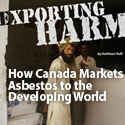Michelle Lalonde from the Montreal Gazette filed this important story on the town of Thetford Mines and their experience with their number 1 export (asbestos) on January 30, 2010. In the article, she discusses the rather insignificant shift in attitude within the municipal government of Thetford Mines – from one that allowed asbestos to be spread on the roads in the winter as a substitute for salt to one that has disallowed this practice, while remaining seemingly unconcerned about the impact that asbestos will have on the long-term health of Thetford Mines residents.
You can read the full article by clicking “more” or by clicking here.
Asbestos: A pile of trouble
Forecasters were calling for snow this week in Thetford Mines. But for the first winter in recent memory, the town is not spreading asbestos-laden mine residue on the roads as an abrasive.
For decades, the local authorities in Thetford Mines have seemed to thumb their collective nose at international health organizations that label the town’s No. 1 export a carcinogen that, when inhaled over long periods, causes deadly lung diseases.
The mountains of uncovered mine residue, or tailing piles, have long been considered benign and simply part of the landscape in this town of 25,000, about 200 kilometres northeast of Montreal. Using the residue as a cheap and amply-available substitute for salt or asphalt was just one more way to make a point.
But last summer, after Mayor Luc Berthold was briefed on a new report on asbestos-related health risks in Thetford Mines, the town made the decision to stop spreading asbestos on the roads.
The report was completed last February, but more than nine months elapsed before it was finally made public last month.
The researchers had concluded that between eight and 125 people out of 100,000 would die of asbestos-related cancer if they were exposed continually over a 70-year lifespan to the concentrations of asbestos fibres found in indoor and outdoor air in Thetford Mines in the fall of 2007. It also said the cancer risk in Thetford Mines is about 17 times higher than that of other communities where asbestos was present (in insulation, for example).
The report recommended more research, of course, but also that the town take measures to reduce public exposure to asbestos dust, such as blocking public access to the tailing piles, not using the residues for infill, and not spreading mining residues on streets as abrasives in the winter.
The study’s authors were not present at the news conference held in Thetford Mines on Dec. 11, but Mayor Berthold, local health officials and asbestos industry representatives who were present said the study showed “very low” risk to the population due to chrysotile asbestos in the air.
Asked why she was not invited to the news conference, study co-author Marie-Hélène Bourgault said her mandate with the Institute national de santé publique du Québec (INSPQ) was to try to quantify the risk, while it fell to local health officials to qualify it.
Critics are concerned this arrangement has lead to the study results being played down, at a time when the asbestos industry needs all the public support it can get.
The Chrysotile Institute, a government-funded industry lobby group created in 1984 “to promote the safe use of chrysotile asbestos” released its own statement the day the damning report was made public.
“This report confirms several studies on the low level of risk associated with low exposure to chrysotile,” said Clément Godbout, president of the Chrysotile Institute.
“It also supports recent scientific data to the effect that at controlled levels of exposure, no measurable risk to health is detected.” Instead of quoting the numbers in the report, the Chrysotile Institute statement, as well as health officials at the Thetford Mines news conference, expressed the results this way: “Over a period of 35 years, there would be 1,000 deaths in Thetford Mines from tobacco-related lung cancer, 100 from traffic accidents and only one from asbestos in the air.” Berthold told The Gazette in an interview that premature death related to smog in Montreal is a much more serious problem than death due to airborne asbestos dust in his town.
And he said the town will not immediately fence off the tailing piles, even though a favourite pastime for some youth in the area is to ride dirt bikes or ATVs up and down the piles.
“The report did not show a cause and effect relationship between the tailing piles and the presence of asbestos fibres in the air,” Berthold said, adding the town is built on an asbestos vein, so the fibres are present in the soil and may occur naturally in the air.
But for longtime critics of Canada’s asbestos industry, the question is not only whether residents of the two towns in Canada where the mineral is mined – Thetford Mines and Asbestos – are being properly informed and protected.
The big question is whether Canada can morally justify the continued mining, use and export of asbestos to developing nations where workplace safety is rarely monitored.
Leslie Stayner, whose research at the University of Illinois School of Public Health focuses on the health impacts of chrysotile asbestos, said it is exceedingly difficult to document asbestos-related diseases in communities where mines and asbestos-related industries have existed. But he says the evidence that exposure to asbestos of all forms causes cancer and asbestosis is “incontrovertible.” In fact, earlier studies have strongly indicated that the population of Thetford Mines has elevated levels of illness and death related to asbestos exposure.
In 2006, a report by the regional public health department of the Chaudière-Appalaches region showed rates of mesothelioma and lung cancer were four to seven times higher in Thetford Mines than in the rest of Quebec, and that the rate of asbestosis was 33 to 41 times higher.
“But the issue is larger than than its impact on Thetford Mines,” says Stayner.
“We need to look at the impact on other communities in the world that import asbestos, where there are much higher levels of exposure,” because of lax safety standards for workers who handle the materials.
© Copyright (c) The Montreal Gazette




February 21st, 2011 at 10:49 pm
I agree with you. Asbestos is really dangerous substance.